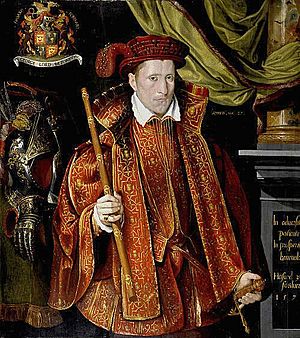Alexander Clark of Balbirnie facts for kids
Alexander Clark of Balbirnie (died 1591) was an important Scottish merchant and a leader of Edinburgh. He was known as the Provost of Edinburgh several times, from 1578 to 1584. He also worked closely with English diplomats, sharing information and helping with important plans. His last name can also be spelled "Clerk" or "Clarke." Balbirnie, his family home, is now part of the town of Glenrothes.
Career

In November 1560, Alexander Clark was in Paris, France. He was an archer in the Scottish Guard and a friend of the English ambassador, Nicholas Throckmorton. Clark got permission to go back to Scotland with a Scottish ambassador, Lord Seton. Throckmorton gave Clark a secret letter for William Cecil in London, recommending Clark's help. Throckmorton wanted Clark's visit to London to be a secret from French diplomats. He also told Elizabeth I that Clark could help her ally, the Protestant James Hamilton, 3rd Earl of Arran, and also had good connections with the Catholic Lord Seton. This meant Clark could send Elizabeth useful secret information about France's plans in Scotland.
Clark wrote to Cecil on 1 January 1561 from Edinburgh. He said that Lord Seton had met with important French leaders, Francis, Duke of Guise and Cardinal of Lorraine. They had also met with two military engineers. Clark reported that they discussed a map of Lindisfarne, also known as Holy Island, which is near Berwick-upon-Tweed. They even had a clay model of the island with two forts they planned to build for France. Clark said their plan was to capture the English fortress town of Berwick by May of that year.
In the 1560s, Clark became an official citizen and guild member in Edinburgh. This happened with the help of the Earl of Moray, who was a powerful leader in Scotland. Clark also became good friends with the English ambassador, Thomas Randolph.
In April 1565, Clark was one of the first people to see ancient Roman remains found near Musselburgh. He described a hypocaust (an ancient Roman heating system) and carved stones to Thomas Randolph. Randolph then sent a copy of an inscription found there to Cecil.
Later in April 1565, Clark sent Randolph a funny letter about politics. He joked about Randolph's personal business and made a silly comment about Randolph's affection for Mary Beaton, who was a companion of Mary, Queen of Scots. He wrote, "And as to your mistress Marie Beton, she is both darimpus and sclenbrunit, and you in like manner without contrebaxion or kylteperante, so you are both worth little money." These were made-up nonsense words.
In September 1567, Clark loaned Regent Moray 530 Pounds Scots (Scottish money). As security for the loan, Moray gave him a gold pendant with black enamel and a long ruby. Clark also worked with another merchant, William Birnie, to sell lead from the roof of Elgin Cathedral.
Clark also loaned money to William Kirkcaldy of Grange, using more of the queen's jewels as security. Grange used this money to pay the soldiers protecting Edinburgh Castle during a long conflict called the "Lang Siege". After the castle was taken, Clark returned the jewels to Regent Morton. In May 1581, Clark asked the Privy Council of Scotland (a group of royal advisors) to make sure he would be paid back if Kirkcaldy's family ever got their lands back.
In February 1580, Clark was paid back £106 by the town's treasurer. This was for a special dinner he hosted for the king and the Privy Council of Scotland.
On 8 June 1582, Clark appeared before the Privy Council of Scotland at Stirling Castle. He and other members of the Edinburgh town council promised to get 8,000 merks (a type of Scottish coin) from the estate of the late Robert Reid, Bishop of Orkney. They planned to use this money to help start the University of Edinburgh.
When Clark was elected as Provost in October 1582, some people in Edinburgh disagreed. The craftsmen (skilled workers) supported Clark, but the merchants (traders) wanted a different person. An English diplomat, Robert Bowes, said the merchants supported a candidate who would be friendly to the English-leaning Raid of Ruthven government.
As Provost of Edinburgh, Clark also loaned money to King James VI. In April 1584, the king's valet, John Gibb, gave Clark a royal jewel. It was a locket with a diamond and an emerald. This jewel was a pledge for a loan of 6,000 merks. In October 1589, the next Provost, John Arnot, gave the jewel back to the king as a wedding gift. Clark's son-in-law, John Provand, delivered it. A goldsmith then updated the jewel, and it was given to Anne of Denmark, the king's new wife, when she arrived in Edinburgh in May 1590.
Marriage and Family
Alexander Clark married Marion Primrose, who was the daughter of the royal doctor Gilbert Primrose. Their children included:
- Alexander Clerk
- James Clark or Clerk of Balbirnie
- Bathia Clark, who married John Provand of Caldhame.
- Magdalene Clark, who married Edward Bruce, 1st Lord Kinloss.
See Also

